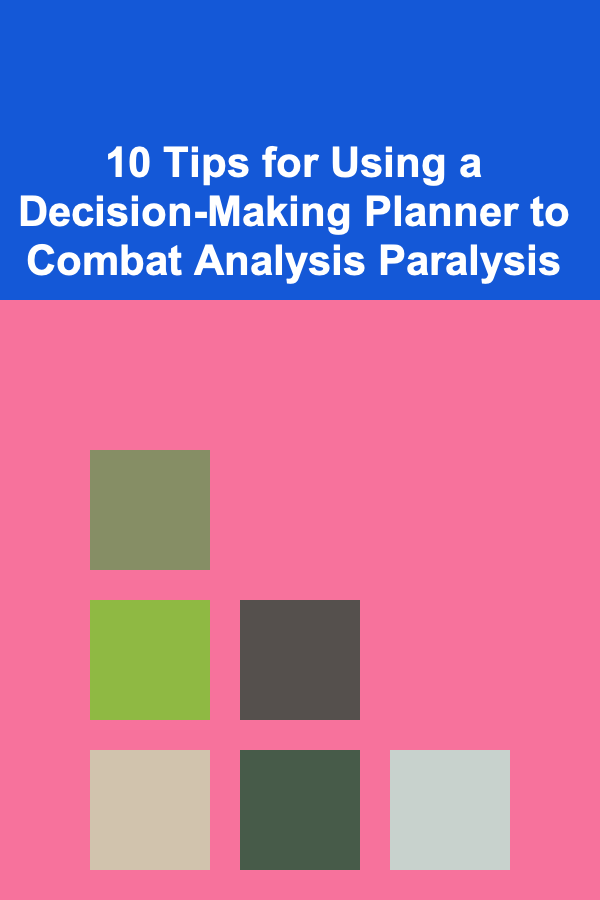
10 Tips for Using a Decision-Making Planner to Combat Analysis Paralysis
ebook include PDF & Audio bundle (Micro Guide)
$12.99$8.99
Limited Time Offer! Order within the next:

In today's world, decision-making has become an increasingly complex process. With endless options and the vast amounts of information available at our fingertips, it's no wonder that many people struggle with "analysis paralysis"---the inability to make a decision due to overthinking and overanalyzing. This issue can range from small, everyday decisions like choosing what to eat for dinner, to more significant life choices such as changing careers or relocating to a new city.
One of the most effective ways to combat analysis paralysis is by using a decision-making planner. This structured approach provides clarity, simplifies the decision-making process, and empowers individuals to make confident choices. In this article, we'll explore ten tips for effectively using a decision-making planner to break free from analysis paralysis and regain control over your decisions.
Start with Clear Goals
Before diving into the specifics of any decision, it's crucial to define your overarching goals. A decision-making planner helps you crystallize your goals and ensures that every decision you make aligns with your larger objectives.
Why It Works:
- Clarifying your goals helps you avoid feeling overwhelmed by the sheer number of options. When you know your desired outcome, you can more easily evaluate choices based on how they contribute to your goals.
- With a goal-focused approach, you're less likely to get distracted by irrelevant options, which helps streamline the decision-making process.
Tip:
- Take a moment to write down your short-term and long-term goals. Whether they're personal, professional, or financial, having a written reference helps you stay focused and grounded throughout the decision-making process.
Break Down the Decision into Manageable Parts
Large decisions can often feel daunting and unmanageable. The key to overcoming this feeling is breaking down the decision into smaller, more manageable parts. A decision-making planner allows you to take a complex choice and deconstruct it step by step, so you're not overwhelmed by the big picture.
Why It Works:
- By breaking a decision into smaller, more digestible pieces, it becomes easier to evaluate each part individually. This helps minimize the pressure and allows you to focus on one aspect at a time.
- It also helps you identify areas that are less critical, allowing you to allocate more energy and attention to the most important elements.
Tip:
- Use your decision-making planner to outline each factor involved in the decision. For example, if you're deciding between two job offers, break the decision down into categories such as salary, job responsibilities, company culture, and career growth opportunities.
Utilize a Pros and Cons List
One of the simplest and most effective tools in any decision-making planner is the pros and cons list. Listing the advantages and disadvantages of each option provides a clear visual representation of how each choice compares to the others.
Why It Works:
- Writing down the pros and cons of each option helps you clarify the trade-offs. You're more likely to make a balanced decision when you can clearly see the benefits and drawbacks of each choice.
- This technique also serves as a valuable tool for organizing your thoughts and reducing emotional overwhelm.
Tip:
- Create a column for each option and write down the pros and cons for each choice. Consider factors such as long-term impact, financial cost, and personal satisfaction. This will help you visualize the potential outcomes of your decision.
Prioritize Key Factors
In many situations, not all factors involved in a decision hold the same weight. Some factors may be more important to you than others. A decision-making planner allows you to rank the importance of each factor, making it easier to evaluate which aspects truly matter in the context of the decision at hand.
Why It Works:
- Prioritizing helps you focus on what truly matters and avoid getting lost in details that won't significantly impact the decision.
- By allocating more weight to critical factors, you can make more informed choices and prevent yourself from getting bogged down by less important details.
Tip:
- In your planner, assign a weight (or score) to each factor based on its importance. For instance, if you're choosing between two career paths, you might give "work-life balance" a higher score than "salary" if that's a higher priority for you.
Consider the Long-Term Impact
While it's easy to get caught up in the immediate benefits of a decision, it's crucial to think about its long-term consequences. A decision-making planner helps you evaluate how each option will affect your future.
Why It Works:
- Focusing on the long-term impact helps you avoid making decisions based on short-term emotions or impulses. By considering future implications, you can make more sustainable choices that will benefit you in the long run.
- Thinking about the long-term outcome also helps you better manage your expectations and reduce regret after making a decision.
Tip:
- In your planner, include a section where you forecast the potential long-term effects of each option. Ask yourself questions like, "Where will I be in five years if I make this decision?" or "How will this choice impact my future goals?"
Use a Decision Matrix
A decision matrix is a powerful tool for comparing multiple options based on several criteria. It allows you to visually rate and compare different choices, helping you determine which option is the best fit.
Why It Works:
- The decision matrix helps quantify subjective decisions by assigning numeric values to each option based on different criteria. This adds an element of objectivity to your decision-making process.
- By using a weighted scoring system, you can evaluate each option in a more structured way, helping you make clearer choices.
Tip:
- Create a decision matrix in your planner with columns for each option and rows for each criterion. Assign a score to each option based on how well it satisfies each criterion. Then, tally the scores to identify the best choice.
Eliminate "Should" and "Could" Thinking
Analysis paralysis often stems from overthinking different possibilities and what others expect of you. A decision-making planner helps you eliminate unnecessary self-doubt and external pressure by focusing on your own preferences and priorities.
Why It Works:
- "Should" and "could" thinking can lead to indecision and second-guessing. By eliminating these thoughts, you create mental space for making choices based on your values, rather than worrying about external expectations.
- Focusing on what feels right for you reduces feelings of guilt and increases the likelihood of making a decision you can be confident in.
Tip:
- When using your decision-making planner, ask yourself what you truly want, not what others think you should do. Clear your mind of other people's opinions and focus on what aligns with your goals and values.
Limit Your Options
Too many choices can be paralyzing. A decision-making planner can help you narrow down your options, so you're not overwhelmed by an array of possibilities. Limiting your options also encourages you to make a more decisive choice without second-guessing.
Why It Works:
- The more options you have, the harder it becomes to choose. By eliminating less suitable options early on, you reduce the mental clutter and focus on the best possible choices.
- Limiting options helps prevent the feeling of being overwhelmed, which often leads to decision fatigue.
Tip:
- Use your planner to narrow down your choices by filtering out options that don't align with your goals or values. If you have more than five options, try to cut them down to two or three that are most in line with your priorities.
Set a Deadline
One of the biggest challenges of decision-making is the endless loop of deliberation. A decision-making planner helps you combat this by setting a clear deadline for when the decision should be made.
Why It Works:
- Deadlines create a sense of urgency and help you avoid procrastination. By committing to a specific timeframe, you prevent yourself from endlessly postponing the decision.
- A deadline encourages you to make a decision based on the available information, rather than waiting for the "perfect" answer, which often doesn't exist.
Tip:
- When using your decision-making planner, set a realistic deadline for making the final decision. This helps you stay focused and prevents you from dwelling too long on the decision.
Trust Yourself
The final and perhaps most important tip for using a decision-making planner is to trust your instincts and judgment. While planners are helpful, they can only guide you so far. Ultimately, you are the one making the decision.
Why It Works:
- Trusting yourself helps you build confidence and reduces the self-doubt that often fuels analysis paralysis. By trusting your ability to make a well-informed choice, you increase your sense of control over the situation.
- Having confidence in your decision-making process helps you move forward and take action without regret.
Tip:
- After using the decision-making planner, take a deep breath and trust the choice you've made. Remind yourself that there is no "perfect" decision, and the important thing is that you're taking action.
Conclusion
Decision-making is an essential skill in both personal and professional life, and with the right tools, you can overcome the challenges of analysis paralysis. By using a decision-making planner, you can simplify the process, focus on what truly matters, and ultimately make more confident and informed choices.
The ten tips outlined in this article provide a comprehensive approach to using a decision-making planner effectively. From setting clear goals and breaking down complex decisions to trusting your judgment, these strategies will help you reduce stress, avoid second-guessing, and regain control over your decisions. So, the next time you find yourself paralyzed by choice, reach for your decision-making planner and take the first step toward clarity and confidence.
Reading More From Our Other Websites
- [Organization Tip 101] How to Plan a Time Capsule Ceremony with Friends and Family
- [Home Renovating 101] How to Identify and Fix Common Issues with DIY Siding Installation and Repair
- [Mindful Eating Tip 101] Mindful Eating Rituals to Boost Energy and Comfort During the Post-Surgery Healing Phase
- [Home Soundproofing 101] How to Soundproof Windows: Best Practices and Products
- [Home Security 101] How to Secure Your Home Against Vandalism and Property Damage
- [Trail Running Tip 101] Injury Prevention Guide: Understanding Risks in Trail Running and Road Running
- [Home Budget 101] How to Save on Home Security Without Compromising Safety
- [Home Storage Solution 101] How to Solve Your Family's Shoe Pile-Up with Creative Entryway Shoe Storage Solutions
- [Home Space Saving 101] How to Use Color and Light to Make a Small Home Feel Bigger: Small Home Decor Ideas Explained
- [Home Maintenance 101] How to Incorporate Current Home Remodeling Trends into Your Maintenance Routine

How to Build a Checklist for Crafting Effective Email Subject Lines
Read More
How to Maintain Your Home's Air Quality
Read More
How to Understand Customer Retention in Print-on-Demand
Read More
How To Boost Your Bone Density
Read More
How To Become a Master Bird Watcher
Read More
How to Decorate a Cake for a Specific Zodiac Sign
Read MoreOther Products

How to Build a Checklist for Crafting Effective Email Subject Lines
Read More
How to Maintain Your Home's Air Quality
Read More
How to Understand Customer Retention in Print-on-Demand
Read More
How To Boost Your Bone Density
Read More
How To Become a Master Bird Watcher
Read More